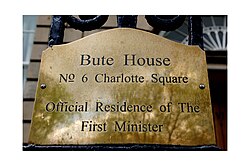
Back Bute House German Bute House Spanish Bute House French Taigh Bhóid Irish בית ביוט HE Bute House Italian ビュート・ハウス Japanese Bute House NB Bute House Portuguese Bute House SCO
| Bute House | |
|---|---|
Taigh Bhòid | |
  Top: Charlotte Square elevation of Bute House (Note: the door is now black) Bottom: Plaque at the main entrance to Bute House | |
 | |
| Former names | No. 6 Charlotte Square |
| General information | |
| Status | Completed |
| Type | Official residence of the first minister |
| Architectural style | Neoclassical |
| Classification | 18th century town house |
| Address | 6 Charlotte Square |
| Town or city | Edinburgh |
| Country | Scotland |
| Coordinates | 55°57′9.360″N 3°12′29.016″W / 55.95260000°N 3.20806000°W |
| Current tenants | First Minister (John Swinney) |
| Named for | The 4th Marquess of Bute |
| Construction started | 1793 |
| Completed | 1805 |
| Client | Scottish Government |
| Owner | National Trust for Scotland (NTS) |
| Technical details | |
| Material | Sandstone |
| Floor count | Five |
| Floor area | 525.65 m2 (5,658.0 sq ft)[1] |
| Design and construction | |
| Architect(s) | Robert Adam |
| Developer | Lord Provost and Edinburgh Town Council |
| Website | |
| Official website | |
Listed Building – Category A | |
| Official name | 1–11 (inclusive nos) Charlotte Square with railings, lamp standards and boundary wall |
| Designated | 3 March 1966 |
| Reference no. | LB28502[2] |
Bute House (Scottish Gaelic: Taigh Bhòid) is the official residence of the first minister of Scotland located within Charlotte Square in Edinburgh. Located at 6 Charlotte Square in the New Town, it is the central house on the north side of the square and was designed by Robert Adam. Bute House was conveyed to the National Trust for Scotland by the 6th Marquess of Bute in 1966. Between 1970 and 1999, it served as the official residence of the secretary of state for Scotland and since July 1999, it has been the official residence of the First Minister.[3]
Alongside two other personal offices at the Scottish Parliament Building and St. Andrew's House, Bute House also contains a smaller office used by the first minister when in official residence.[4] As well as serving as the official residence of the first minister, Bute House is frequently used by the First Minister to hold press conferences, media briefings, meetings of the cabinet of the Scottish Government and appointing members to the Scottish Cabinet.[5]
The four-storey house contains the Cabinet Room, offices and conference, reception, sitting and dining rooms where the first minister works and where Scottish Government ministers, official visitors and guests are received and entertained. The second and third floors contain the private residence of the first minister.
- ^ Lothian Valuation Joint Board (1 April 2017). "Bute House, 6 Charlotte Square – Summary Valuation Sheet, 2017 Revaluation". Scottish Assessors Association.
- ^ "1–11 (Inclusive nos) Charlotte Square with railings, lamp standards and boundary walls (LB28502)". portal.historicenvironment.scot. Retrieved 10 March 2020.
- ^ "History of Bute House". Scottish Government. Retrieved 23 June 2015.
- ^ "Bute House". First Minister of Scotland.
- ^ "Bute House – Edinburgh Guide". www.edinburghguide.com.